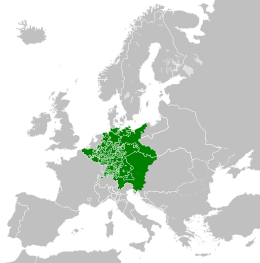More languages
More actions
| Holy Roman Empire Heiliges Römisches Reich Sacrum Imperium Romanum | |
|---|---|
 The empire in 1789 | |
| Common languages | German Latin |
| Dominant mode of production | Feudalism |
| Government | Monarchy |
| Population | |
• 1800 estimate | 29,000,000 |
The Holy Roman Empire was a political entity in Central Europe during the medieval and early modern periods. It was deeply divided and had internal conflicts between the Emperor and local princes.[1]
History
Under the rule of the Hapsburg dynasty, the Holy Roman Empire fought with Spain against France from 1494 and 1559 in northern Italy.[2]
Protestant Reformation
The Protestant Reformation began in what is now Germany in 1517. The Holy Roman Emperor summoned Martin Luther to the Diet of Worms in 1521 and threatened to execute him, but his teachings soon spread across the empire to two-thirds of German villages. Impoverished knights in southern Germany revolted from 1522 to 1523 followed by a peasant rebellion from 1524 to 1525 that threatened the entire feudal mode of production. Many German princes who opposed the Pope and Holy Roman Emperor converted to Protestantism.[1]
References
- ↑ 1.0 1.1 Neil Faulkner (2013). A Marxist History of the World: From Neanderthals to Neoliberals: 'The First Wave of Bourgeois Revolutions' (pp. 94–102). [PDF] Pluto Press. ISBN 9781849648639 [LG]
- ↑ Neil Faulkner (2013). A Marxist History of the World: From Neanderthals to Neoliberals: 'European Feudalism' (p. 88). [PDF] Pluto Press. ISBN 9781849648639 [LG]


